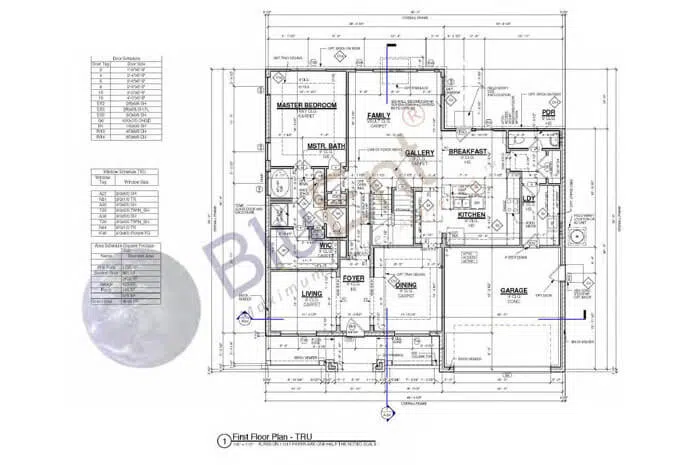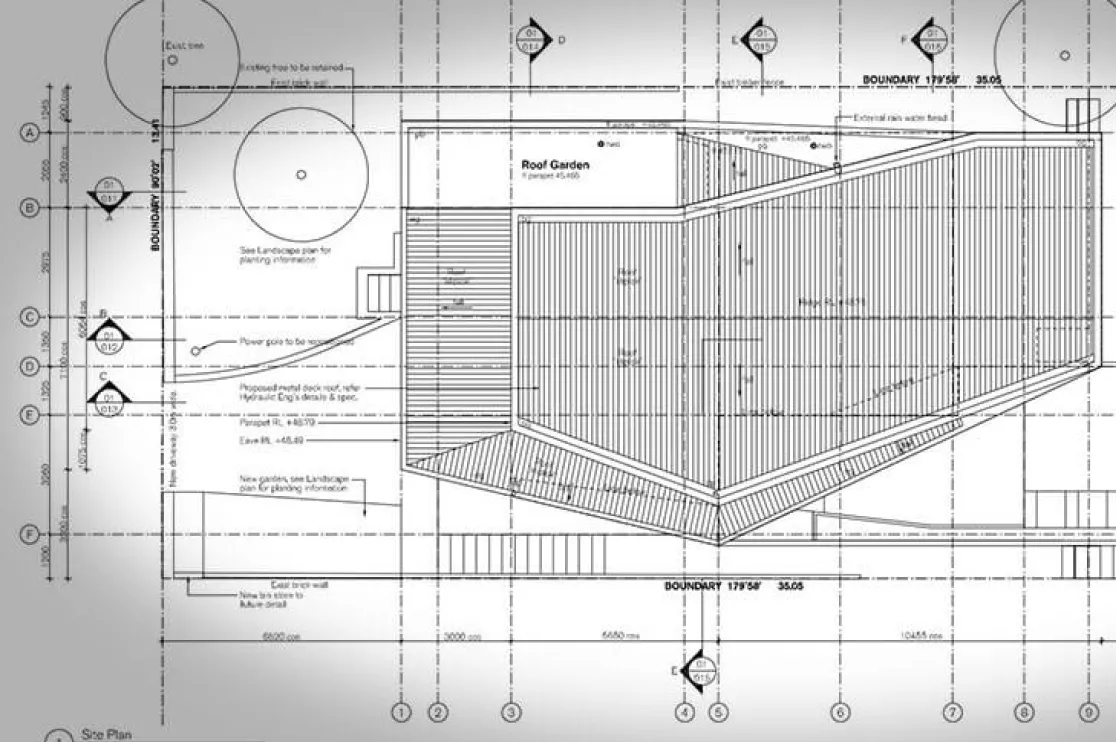You cannot successfully execute any construction project without a foundation plan drawing, which is part of construction documentation.
Without a strong foundation, your building will be dangerous and unreliable, and not last a long time. It is vital to ensure that the structure is earthquake resistant, as well as resistant to rain and wind.
In this article, we’ll take you through the definition and importance of foundation plans.
Table of Contents
- What is a Foundation?
- What is a Foundation Drawing Plan?
- Application of Foundation Plan Drawings
- Components of a Foundation Plan Drawing
- Benefits of Foundation Plans
- Types of Foundation Plan Drawings
- Foundation Plan Drawing Requirements
- Steps to Create a Foundation Drawing
- Reading and Interpreting Foundation Plan Drawings
- Difference Between Foundation Plan and Basement Plan
- Future of Foundation Plan Drawings
- Conclusion
- Frequently Asked Questions
What is a Foundation?
Before we get started on foundation plan drawings, let’s define a foundation.
A foundation is the lowest part of a structure, sandwiched between the building and the ground. Its goal is to distribute the load from the house to the soil. It is imperative that it can withstand the weight of the building.
Usually, foundations are built with poured concrete or masonry, such as brick or concrete blocks.
Masonry is resistant to damage from soil and moisture and has high compressive strength. A masonry foundation protects other materials by extending above the ground. Such a foundation is generally reinforced with other materials such as metal.
In some cases, foundations are created with piers or treated wood posts. These either rest on concrete or rock pads or are driven deep into the soil. Piers and posts are often used where the land is prone to flooding or when one is building on or near a water body.
It is difficult to overstate the importance of getting the foundation right. A poor foundation has a domino effect. If it does not serve as a stable starting point, then the walls, support beams, and base will follow suit.
Hence, if you fail to invest appropriately in the foundation plan drawing, it could lead to the building being dangerous and to expensive modifications and repairs.
What is a Foundation Drawing Plan?
The foundation plan drawing offers a plane view of a building, that is, a top view of the foundation walls. It is an aspect that is part of structural drawings and it shows:
Area and locations.
Girders, beams, columns/piers, and openings.
Dimensions and internal composition.
Foundation plans are primarily used by the building crew. As their name suggests, they involve the development of a plan for the building’s foundation.
The creation of a foundation plan is a highly specialized function. Typically, it is done by a structural engineer and involves an extensive study of both the ground beneath the foundation and the materials used for the foundation.
The foundation plan draws on information given in the elevation plans, floor plans, and plot plans.
Advanced technologies have significantly enhanced the process. For instance, BIM now allows for detailed 3D modeling of the foundation, integrating it with other building systems for improved coordination and clash detection.
Additionally, geotechnical software can provide more accurate soil analysis, ensuring that the foundation design is adapted to the site’s specific conditions.
 Floor plan by BluEntCAD
Floor plan by BluEntCAD
Recommended Reading:
Applications of Foundation Plans
Foundation design and layout
The layout sets the tone for the whole project. It shows where columns, walls, and footings will sit so that the load is evenly distributed. Without this, you’re basically building blind.
Pinning Down the Right Materials
Foundation drawing details such as concrete grade, reinforcement type, steel thickness etc remove the guesswork and make sure contractors use exactly what’s required.
Planning for long-term strength
Engineers lean on foundation plan detail drawings to calculate how the base will handle both vertical loads and side forces. This is what keeps the structure standing over decades, not just years.
Soil and site analysis
The foundation plans often reflects soil capacity and ground conditions. If the soil isn’t strong enough, the design adapts. That’s how you avoid settlement issues later.
Utility check and integration
Utlities such as pipes, drainage, conduits etc all need to run smoothly through the site. The foundation plan layout makes sure they don’t clash with footings or slabs.
Right depth and elevation
Foundation plan footing details specify how deep you dig and at what elevation the plinth sits. These numbers matter because a few inches off can throw the whole alignment.
Coordination with other trades
Whether it’s plumbing, electrical, or HVAC, a foundation plan for residential buildings (and commercial ones too) keeps all trades working from the same playbook.
Permissions and compliance
Most jurisdictions won’t greenlight your project without foundation plans. It’s proof that the design meets safety codes and local building regulations.
Guiding pours and inspections
Foundation plans for houses guide the contractors during concrete pours and inspections to double-check dimensions and reinforcement. It’s about quality control before moving up.
Cost estimation
With foundation plan dimensions in place, estimators can pin down accurate costs and reduce overruns. No surprises, no inflated budgets.
Components of a Foundation Plan Drawing
Foundation plan drawing is indeed a roadmap that tells builders exactly how to start the project right. Let’s understadn what’s contained in these foundation plans:
Foundation layout – The overall sketch that shows where every wall, footing, and column will sit.
Dimensions and floor elevation – Exact measurements and levels that guide digging and alignment.
Footings – The base details that carry the load from the building into the soil.
Walls, columns, and piers – The vertical elements that rise from the foundation to support the structure above.
Reinforcement specifications – The type, size, and placement of steel bars that strengthen the concrete.
Foundation materials – Information on concrete, steel, or other materials needed for construction.
Drainage details – Notes on how water will be directed away from the building to avoid long-term damage.
Stair and elevator pits – Markings for the recessed areas where stairs and lifts begin.
Utility lines and connections – Paths for plumbing, electrical, and other services that pass through the foundation.
Access points and excavation notes – Directions on how to dig, enter, or prepare the site before pouring concrete.
Site information – References to soil conditions, property boundaries, and nearby features.
Benefits of Foundation Plan Drawings

If you’ve ever wondered why architects, engineers, and contractors keep stressing on foundation plan drawings? Here’s the answer to why foundation plan drawings are essential.
Keeps the structure stable
A foundation plan drawing shows exactly how the weight of the building should sit on the ground. Done right, it reduces risks like cracks or uneven settling.
Helps avoid long-term issues
By factoring in soil type, load, and local conditions, a good plan keeps the building strong and less prone to future repairs.
Clear guide for construction teams
Contractors get accurate details on footing size, layout, and materials. That means they know exactly what to build instead of guessing on-site.
Smooth site preparation
From excavation depth to concrete placement, foundation drawing details act like a step-by-step map to get the groundwork right.
Saves money and time
When the foundation plan is clear, mistakes and rework are less likely. That keeps the project on schedule and within budget.
Meets code and standards
Foundation plan detail drawings are designed to align with building codes, ensuring the structure can withstand local loads, weather, and soil conditions.
Improves communication and costing
Accurate foundation plan dimensions and specs make it easier for contractors to give reliable estimates and keep everyone aligned on expectations.
Types of Foundation Plan Drawings
Foundation plan drawings generally fall into three main categories:
Shallow Foundations – sit near the surface and are used when the soil can safely carry the building’s weight.
Deep Foundations – extend far below the ground to reach stable soil or rock, perfect for tall or heavy structures.
Combined Systems – mix shallow and deep elements to give extra support in challenging soil conditions.
Here are some common foundation plans examples you’ll encounter, including residential and commercial setups:
| Type of Foundation | Category | When It’s Used | What the Drawing Shows |
|---|---|---|---|
| Slab-on-Grade | Shallow | Single-story homes, stable soils, warm climates | Shows a concrete slab poured directly on the ground with reinforcement, as a standard foundation drawing for houses. |
| Full Basement | Shallow | Homes in colder regions or needing extra space | Details walls, stairs, drainage, and waterproofing in the foundation plan drawing. |
| Spread Footings (Strip/Wall/Trench Footings) | Shallow | Load-bearing walls, light to medium buildings | Shows continuous concrete strips or trenches under walls as part of a footing foundation plan. |
| Isolated/Pad Footings | Shallow | Columns or piers support | Illustrates individual square or rectangular footings supporting columns in the footing foundation plan. |
| Mat (Raft) Foundation | Shallow | Weak soil or heavy/wide buildings | Displays a thick slab covering the building footprint with reinforcement in the foundation plans example. |
| Pier and Beam | Shallow / Hybrid | Moist soils, elevated houses | Shows piers and beams with proper clearance and ventilation in the foundation plan layout. |
| Slab-on-Grade with Stem Walls | Shallow | Mix of slab + raised wall support | Illustrates slab plus reinforced stem walls in the foundation plan layout. |
| Grade Beam Foundations | Shallow | Flood-prone or moisture-heavy areas | Shows beams, footings, and moisture protection details in a clear footing foundation plan. |
| Pile Foundation | Deep | High-rise, heavy loads, poor surface soil | Shows pile locations, pile caps, and reinforcement as part of a foundation plan drawing. |
| Drilled Piers (Caissons) | Deep | Towers, bridges, heavy structures | Displays depth, diameter, and reinforcement cages in a professional foundation plan drawing. |
| Pile Raft Foundation | Combined | Weak soil + high loads | Illustrates how piles work together with a raft slab in the foundation plan layout. |
| Tilt-Up Foundation | Special / Hybrid | Industrial or commercial buildings | Shows panel lifting points, connections, and slab interface in foundation plan drawings. |
Foundation Plan Drawing Requirements
The following checklist of features will help you to guarantee that your plan is up to the mark. It is not exhaustive, but it serves as a guide:
Door sizes & locations
Heating appliances
Exterior walls
Existing attached structure
Plumbing location
Fireplace location
Drains & sump (if required)
Room sizes & names
Window sizes & locations
Footings for foundation walls, columns, and piers
Dwarf walls
Dimensions & notes
Structural reinforcements
Thermal insulation
Foundation dimensions
If the foundation plan involves non-standard construction or is slab on grade, a professional, stamped design must be submitted.
Steps to Create a Foundation Drawing
Select the location of the structure
Select the scale for your drawing
From the floor plan, locate the outline of the foundation walls
Draw foundation walls, columns, and piers
Use breaks in the walls to indicate doors, windows, vents, and access holes
Draw footings for foundation walls, then for columns and piers, and finally for chimneys and fireplaces
If required, draw a supporting beam with a centerline symbol
Display the direction, spacing, and size of floor trusses or joists
Add in necessary dimensions and sections
Letter required notes
Shade wall drawings
Reading and Interpreting Foundation Plan Drawings
Here’re some easy ways to understand Foundation plan drawings in a very easy manner.
Learn the symbols and abbreviations used for concrete, rebar, and dimensions
Review the site layout including footprint, topography, setbacks, and boundaries
Identify the foundation type such as slab-on-grade, crawl space, full basement, or pier and beam
Check footing details including size, placement, and reinforcement
Look at foundation walls and columns for dimensions, materials, and rebar placement
Identify drainage and utility systems like water, sewer, and electrical lines
Understand slab details including thickness, reinforcement size, and spacing
Check for special features such as expansion joints, anchor bolts, and vapor barriers
Refer to elevations and sections for depth, height, and hidden details
Cross-check with structural drawings to ensure proper reinforcement and measurements
Difference Between Foundation Plan and Basement Plan
It could be easy to confuse a basement plan for a foundation plan, especially since the procedures for drawing both are the same.
However, it is important to note their differences. The foundation plan drawing provides necessary information for the people who are building the foundation.
On the other hand, the basement plan includes both the foundation plan and the floor plan, and shows stairs, windows, doors, interior walls and built-in appliances of fixtures using detailed 3D visualizations and interactive models, allowing for more accurate representation and integration of structural and architectural elements.
Future of Foundation Plan Drawings
Talking about trends and technologies, here’s what’s coming next in foundation plan drawings to make them smarter, faster, and easier to use.
Advanced Digital Tools & AI
Smart CAD software and AI help create optimized foundation layouts, automate detailing, and spot potential design issues before construction.
BIM Integration
Building Information Modeling (BIM) gives 3D, data-rich models for clash detection, simulations, and smooth collaboration across teams.
Virtual & Augmented Reality
VR and AR let engineers and clients explore foundation plan layouts in an immersive way before construction begins.
Sustainable & Smart Foundations
Future foundation plan drawings include eco-friendly materials like recycled concrete and geopolymer composites, plus sensors for real-time monitoring and seismic resistance.
Data Integration & Coordination
Foundation plans link with site-specific soil data and other architectural, mechanical, and structural plans to create optimized, resilient, and unified designs.
Conclusion
We hope this article has given you an insight into foundation plan drawings and their importance for construction projects.
Getting them right can be tricky, and it’s best to get them done with professional construction drawing services. BluEntCAD serves homebuilders, architectural and engineering companies, home designers, and real estate developers for large—to medium-sized hospitality, commercial, and residential projects. Check out our portfolio to see how we’ve helped companies like yours.
Ready to make your construction project a success with accurate construction drawings? Contact us now!
Frequently Asked Questions
Why are foundation plans important?Foundation plans are important because they provide a clear guide for builders and engineers to ensure structural stability. Whether it’s a residential building or a commercial project, these plans show how footings, walls, and columns will support the structure above.
What is the purpose of foundation plans?The purpose of a foundation plan is to communicate the exact layout, dimensions, and details of the foundation to construction teams, ensuring accurate implementation of the design.
How are foundation plans used in construction projects?Builders use foundation plan drawings to prepare the site, set out footings, pour concrete, and place reinforcement. These drawings act as a blueprint so construction matches the architect’s design.
What information is typically included in foundation planning?Foundation plan detail drawings include footing sizes, foundation wall dimensions, reinforcement specifications, anchor bolt positions, drainage provisions, and any special instructions for soil or load conditions.
Are foundation plans required for all construction projects?Yes, foundation plans are essential for houses and other buildings. They are often needed for permits and ensure that the construction follows local building codes.
Can foundation plan drawings be modified or revised during construction?Yes, footing and foundation plan drawings can be updated if site conditions or design changes require it, but revisions should always be coordinated with engineers or architects.
What is Foundation Plan?A foundation plan drawing shows the layout, size, and materials for a building’s foundation. It transfers the load of the house safely to the ground.
What is foundation and its purpose?The foundation is the base of a building that distributes its weight evenly to the soil. Its purpose is to provide stability and prevent settling or structural damage.
Who designs foundation plans?Structural engineers or architects create foundation plan drawings. They ensure the design is safe, accurate, and compliant with regulations.
How to estimate foundation plans?Estimating a foundation plan involves calculating the cost of materials, labor, excavation, equipment, and reinforcement. Footing foundation plan drawings often help in measuring quantities accurately.
How to draw foundation step by step?Start with site selection and scale, locate the outline from the floor plan, draw walls, columns, and piers, add footings, show reinforcement, mark utilities, and finally include dimensions and notes. Free foundation plan drawings or AutoCAD files can help as references.
How to read foundation plan layout?Foundation plan reading involves checking symbols, identifying key components like footings and walls, reviewing dimensions, verifying elevations, and inspecting drainage and utility connections.
What is an example of foundation plan?A common example is a footing and foundation plan, showing the positions of footings, columns, and walls. Foundation plans for houses often include slab-on-grade or pier-and-beam layouts.
What is the difference between Foundation Plan and the Basement Plan?A foundation plan shows structural elements like footings, walls, and columns, while a basement plan focuses on room layouts, doors, and finishes below the ground floor.
What are the four types of foundation?The main types include shallow foundations (like strip or spread footings), deep foundations (pile foundations), slab-on-grade foundations, and pier-and-beam foundations.
Who makes foundation plans?Foundation plan drawing services are typically offered by structural engineers, architects, or specialized foundation plan drawing companies.
What is column footing?Column footing is the part of the foundation that supports individual columns, transferring vertical loads safely to the soil. Footing foundation plan drawings show their exact size and placement.
Which type of foundation is best for a house?For most houses, slab-on-grade or pier-and-beam foundations work best, depending on soil conditions and load requirements. Foundation plans for houses guide the choice.
What is a foundation plan drawing?A foundation plan drawing shows the arrangement, size, and reinforcement of footings, walls, and columns, often including dimensions, drainage, and utility lines.
What type of drawings are foundation plans found on?Foundation plan drawings are typically part of architectural or structural drawings. They can be found as foundation floor plan drawings, AutoCAD files, or PDF versions for reference.


















 From Blueprints to 3D Visuals: Building Construction Portfolio That Win Clients
From Blueprints to 3D Visuals: Building Construction Portfolio That Win Clients  What Are Construction Specifications? Complete Guide
What Are Construction Specifications? Complete Guide  What is Construction Document Management Software?
What is Construction Document Management Software?  What Do SD, DD & CD Stand for in Construction?
What Do SD, DD & CD Stand for in Construction?